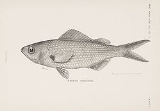
Galapagos damsel
Encyclopedia
The Galapagos damsel also known as Blackspot chromis, is a possibly extinct fish species from the family of Pomacentridae
. It was endemic in the waters near the Galápagos Islands
and Cocos Island
.
was collected near Cocos Island
. The Galapagos damsel was a plankton feeder.
activity led to an increase of the water temperatures nearby the Galapagos Islands. The plankton production was turned off for at least one year and this led to a complete breakdown of the Galapagos damsel population. Despite intensive searches during the next decade the Galapagos damsel was not found again.
Pomacentridae
Pomacentridae are a family of perciform fish, comprising the damselfishes and clownfishes. They are primarily marine, while a few species inhabit freshwater and brackish environments . They are noted for their hardy constitutions and territoriality...
. It was endemic in the waters near the Galápagos Islands
Galápagos Islands
The Galápagos Islands are an archipelago of volcanic islands distributed around the equator in the Pacific Ocean, west of continental Ecuador, of which they are a part.The Galápagos Islands and its surrounding waters form an Ecuadorian province, a national park, and a...
and Cocos Island
Cocos Island
Cocos Island is an uninhabited island located off the shore of Costa Rica . It constitutes the 11th district of Puntarenas Canton of the province of Puntarenas. It is one of the National Parks of Costa Rica...
.
Description
The Galapagos damsel reached a length of 15 cm. The colour was predominantly light olive grey with a light blue tint. The ventral side was silvery. The mouth was dusky.Biology and occurrence
The Galapagos damsel was known from following regions: Floreana, Gardiner Bay, Española, Tagus Cove, Isabela, Marchena, James Bay and Sullivan Bay, Santiago, Wreck Bay, San Cristóbal, Academy Bay, Santa Cruz and Santa Fe. One specimen which is on display in the American Museum of Natural HistoryAmerican Museum of Natural History
The American Museum of Natural History , located on the Upper West Side of Manhattan in New York City, United States, is one of the largest and most celebrated museums in the world...
was collected near Cocos Island
Cocos Island
Cocos Island is an uninhabited island located off the shore of Costa Rica . It constitutes the 11th district of Puntarenas Canton of the province of Puntarenas. It is one of the National Parks of Costa Rica...
. The Galapagos damsel was a plankton feeder.
Extinction
The 1982/1983 El Niño-Southern OscillationEl Niño-Southern Oscillation
El Niño/La Niña-Southern Oscillation, or ENSO, is a quasiperiodic climate pattern that occurs across the tropical Pacific Ocean roughly every five years...
activity led to an increase of the water temperatures nearby the Galapagos Islands. The plankton production was turned off for at least one year and this led to a complete breakdown of the Galapagos damsel population. Despite intensive searches during the next decade the Galapagos damsel was not found again.

